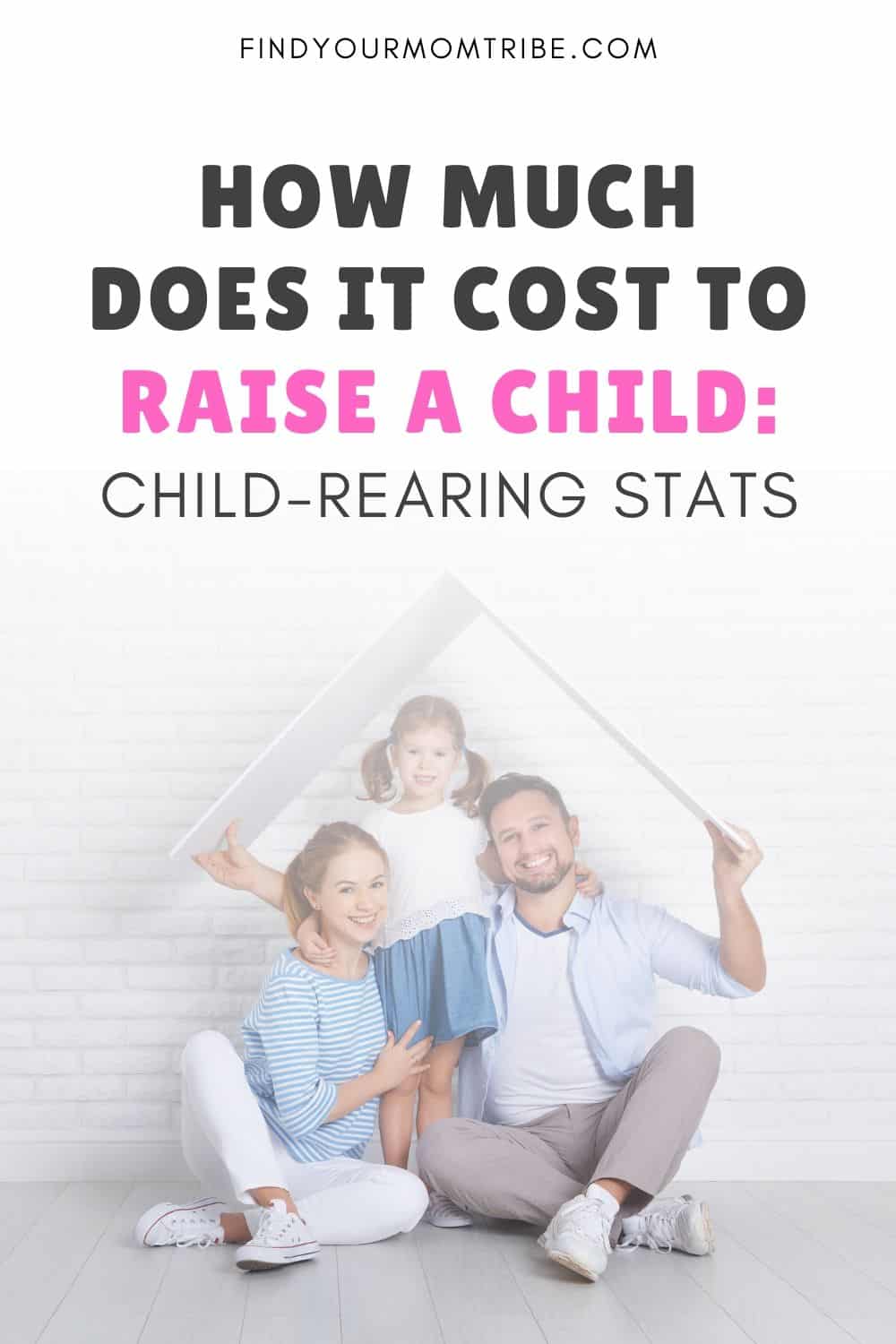Do you have a baby on the way or are your kids already growing? Kids of any age are wonderful! But if you’re one of those running to the search engines to ask “How much does it cost to raise a child?” there are some shocking numbers that you’re about to discover. The estimated cost of raising a child for a middle-income, married couple with two kids is $233,610, according to a 2017 report by the US Department of Agriculture.
And this is even before college…
Interestingly, this figure covers costs from infancy through the age of 17; it does not include college expenses.
When you include inflation costs, it could be up to $284,570. This means that households can expect to spend between $12,350 and $14,000 per year on average to raise a child.
The cost of raising a child
Who are the hard-hitters?
Housing, food, transportation, healthcare, education, childcare, clothing, personal care items, and entertainment costs are some of the biggest reasons why little humans cost so much.
RELATED: How To Prepare For A Baby Financially: 24 Ideas That Can Help
Housing recorded the biggest expense for middle-income families, accounting for 29% of the total cost of raising a child.
The USDA arrived as this number by calculating the average cost of an additional bedroom.

Food is the second highest budget killer. For a middle-income couple with two kids, food costs account for almost a fifth of the cost of raising a child.
Childcare is next, as this costs parents an average of $37,378 per child according to the government.
Despite the endless onslaught of diapers and other disposables, younger children tend to be less expensive. Childcare and education expenses constitute 16%.
Education costs have experienced a sharp accent since 1960, when the Department of
Agriculture estimated that those expenses were around 2% of child-rearing costs.
This growth, according to the report, is due to the increased number of women in the labor force, necessitating the need for more childcare.
Child age and living costs dynamics
Whereas childcare and tuition costs are higher for kids under the age of six, those expenses wane as the children get older and enter school full-time.
Our expenses like transportation, healthcare, food, and clothing costs rise as children age.
For instance, parents with teenage children can expect to fork out the greatest amount on food.
In 2015, the annual average cost to feed a 15-to-17-year-old stood at $2,790 in 2015 – 22% higher than what it costs to feed a child between the ages of 6 and 8.
Kid’s transportation costs are burdensome on the family budget, but it dropped 7% over the years thanks to lower gas prices.
Having more kids can alleviate some financial pressure (the cheaper-by-the-dozen effect).
As a household expands and has more children, costs become lower per child.
According to the USDA, married-couple families with three or more children spend an average of 24% less per child compared to those with two children.

Children may share a bedroom and clothing, toys can be reused, and food can be bought in larger, more economical packs.
However, as they grow older, these kids will be way more expensive.
They eat more, meaning that they have higher food costs, and have higher transportation costs.
While new parents may cringe at the costs of baby gear and diapers, it will only get worse. A child that is aged 0 to 2 costs around $12,680, but a teenager between 15 and 17 costs as much as $13,900 per annum.
The USDA says that food, transportation, clothing, and healthcare costs increase as the child advances.
Transportation expenses are highest for older kids perhaps because they start driving and get into trouble more often.
Childcare and education costs are highest for kids aged six and below.
The cost of raising a child across region and income cadres
The cost of raising a child, however, varies according to family income level and location.
Low-income families are estimated to spend a total average of $174,690, while high-income families pay nearly double: $327,210.
Regionally speaking, families in the urban Northeast endure the highest child-rearing tab with an average of $253,770.
This is seconded by the urban West at $235,140, with the urban Midwest spending relatively less ($217,020).
People residing in rural areas across the country pay as low as $193,020 on average according to the government.
The USDA also estimates annual housing cost per child in urban centers to be $3,900, while it is $2,400 in rural areas.
The average middle-income family earns between $59,200 and $107,400 before taxes.
Parents living in the urban Northeast also pay the most on housing, education, and childcare.

How much does it cost to raise a child as frugally as possible?
Here are the best estimates for raising a child just above bare-necessity levels.
Housing
A USDA study shows that the average housing cost is $3,680 per kid per year.
The largest portion of a middle-income family is assigned to housing expenditure.
This is the most expensive aspect of raising a child as it gulps up to 29% of the total household income.
Housing kids in urban areas is more expensive (27%) than in rural areas.
On average, low-income families spend $3,160 on average while a middle-income household spends $3,680 on housing expense monthly.
Thankfully, the larger your family is, the bigger your savings on housing expenditure.
Families with three or more kids spend an average of 24% less per child. In contrast, one-child households spend 27% more on the single child on average.

Furthermore, the USDA discovered that the fewer children you have, the more expensive things will cost.
With more children, you’d be buying food and supplies in bulk and saving more than if you were buying in small portions for fewer kids.
The child cost of housing remains unchanged from the moment a child is born up to his or her 17th birthday. The cost of a room remains the same.
So, if you’re looking to start a family, wondering how much it costs to raise a child, or having challenges keeping up, move to a lower-cost city with cheaper housing in a decent school district.
For the frugal family paying for less expensive housing, you can get away with $10,000 per child per year ($833) per month.
These estimates are based on apartment rent that costs $800 for a 1-bedroom, $1,000 for a 2-bedrooms, and $1,200 for a 3-bedroom apartment.
Get coupons from your real estate agent. Many agents have access to coupons from Home Depot, Lowe’s, and other stores.
They offer at least 10% off any purchase. All you need to do is just ask.
You can ask for coupons for both you and your spouse so that you can get those 10% discounts more than once.
Food
Food is the second most expensive expense when raising kids. Fortunately, it’s also the area where a family has more options to save.
According to reports from the USDA, 18% of the total cost to raise a child goes toward food.
Additionally, as the child grows, so does food consumption.
According to the study, teenage children are the greatest food consumers.
Food consumption for low-income families range from $1,310 to $2,300 according to age. Mid-income families spend $1,580 to $2,790.

There are a number of ways to save money and time preparing food for the family. Budget meal planning can save you a lot of money on food.
Buying in bulk for the whole week or month, creating a monthly meal planner, cooking in large batches to then stock up in the freezer and pantry, and clipping food coupons are some of the ways you can save time and money, and ultimately solve the “how much does it cost to raise a child” puzzle.
Doing these would result in around $4 per day for your children’s food budget. Coincidentally, this is about the same amount food stamps cost.
Healthcare: Target $900 per year
Healthcare coverage accounts for around 9% of the cost of child-rearing.
A low-income family spends up to $820 to $910 annually, depending on the child’s age.
Middle-income families spend around $1,180 to $1,300 – this again dependent on the child’s age. As the child grows older, the coverage needed for healthcare increases.

Healthcare cost is an expense that needs to be planned ahead of time.
One of the best ways to save money is to get healthcare sharing and insurance coverage, where the cost of other people’s healthcare is shared.
Healthcare Savings Account (HAS) is an emergency fund for medical expenses.
It is a great option when coupled with healthy food and lifestyle choices.
You could even achieve lower figures than $900 per year. There are families that go without health insurance for the majority of their lives.
Their kids live a no frills lifestyle. No leg sprains, no appendicitis, no sports, and so on.
Furniture and appliances: Target $300 per year
Sometimes used furniture is almost as good as new.
It can be great to buy higher-quality hand-me-downs than you couldn’t afford to purchase new.
Go to yard sales or garage sales. Hit Craigslist or eBay to find the best thrift deals.
Anything from car seats and cribs, to vanity tables and mattresses can be found at dropped prices. So, visit your local thrift store more often.
Buy returned or used appliances, liaise with the store managers and ask if they stock gadgets that people have returned.
Consider used appliances.
If you get a 90-day warranty, chances are if they lasted that long, they’re unlikely to break anytime soon.

Have you considered training yourself and your kids to make your own repairs?
One of the ways to ensure your furniture and appliances last long is to repair them yourself.
You don’t need to be mechanically or electrically inclined to fix washing machine leaks or tighten up loose furniture legs.
There are lots of DIY tutorials on YouTube that you can find helpful on this subject.
Clothing: Target $100 per year
Clothing plunders up to 6% of a family’s annual budget and would be less if the family had more kids.
The cost reduction in a big family is due to the younger children inheriting old items from their older siblings.
According to USDA estimates, a low-income family spends from $670 to $720 per child per year on clothing, while a middle-income family spends $720 to $830.

To save big on clothing, shop on least-known brands.
Additionally, talk to your kids early on about getting obsessed with brand names, explaining how impractical they are and they shouldn’t be a base for their identity.
Shop on occasion and only if necessary. Be on the lookout for good deals on clothes.
Education: Target $30 to $900 per year
Perhaps the greatest thing about the Western world is free education.
A public school will allow you to save money if you have more children.
The best way to save is to choose an up-and-coming neighborhood in a district with high-quality schools.
Consider riding the school bus instead of being driven to school. Also, find out if you qualify for free or reduced lunch.

Find creative ways to reduce expenses.
Between play centers, arcades, gym classes, and elaborate birthday parties, there are things you can trim.
That $200 you’re about to spend on Junior’s birthday party could be cut to $100, while the other $100 could be invested into a target savings account or college fund.
Childcare: Target $500 per year
This is the third most expensive item in the annual family budget (16%).
Interestingly, this is the only item on the list that decreases over time, as the need for childcare decreases with increasing age of the child every year.
The first 5 years of raising a child are expensive as it covers the fee for daycare, nannies, and others.
While high-income families tend to spend more, low-income families save more by staying at home (since their income can’t cover expensive daycare costs).
Consider your eligibility for government subsidies and scholarships funds for K-8 and K-12 funding.
To be frugal, you may consider spending on a babysitter occasionally for a night or two per month.

Take advantage of child tax credits, which serve to help parents offset the costliness of raising a child.
Under Trump’s new tax plan, the credit jumped from $1,000 to $2,000 in 2018.
Unlike a deduction, tax credits are a dollar-for-dollar reduction on the total tax bill.
If you qualify, be sure not to leave that free cash on the table.
Transportation: Target $1,000 per year
Depending on your location, there should be locally subsidized bus fares. Children under the age of 5 ride in buses for free.
Allow for a healthy $1,000 per year budget in a region with a fair transportation system.
Transportation takes 15% of the total cost to raise a child. And just like most of the other expenses, it increases as the child ages.
These costs involve commute expenses in families without a vehicle and fueling and car maintenance costs for families with a vehicle.

When a kid turns 17, he or she starts to travel more. This wanderlust makes it even more expensive with or without an automobile.
The additional car insurance cost is also one of the reasons why transportation expense increases as the child advances.
Therefore, consider saving money by not gifting a teenager a car.
Also, save more money on transportation by opting for free alternatives, especially in bicycle -friendly neighborhoods.
Vacations: $0 per year
When things are tight, I mean, vacations are really not necessary.

Miscellaneous costs
Miscellaneous expenses constitute up to 7% of the total cost to raise a child.
According to the USDA, this covers recreation and entertainment, and other overheads. Personal care products, entertainment, and sports gear belong to this category.
During a child’s transition to teenage-hood and adulthood, he or she will develop hobbies, indulge in entertainment, and accrue related costs.
Depending on age, low-income families spend from $450 to $750 per child on a yearly basis. Middle-income families usually spend $830 to $1,110.
Families spend the most on the age range of 9 to 10.
Expenses decline after reaching 12 to 14, and 15 to 17 when most teenagers are out seeking jobs.

How to save for a child
As soon as you ask “how much does it cost to raise a child,” you want to start thinking about their future in earnest.
That way, your investments will have more time to flourish and yield greater profits.
Look for opportunities in tax-advantaged 529 college savings plans, which allow you to save towards your child’s education costs.
When it’s time to pay for tuition, books, gear, etc., your child can make free tax withdrawals.
You can also set up custodian accounts like Uniform Gift to Minors Act (UGMA) and the Uniform Transfers to Minors Act (UTMA) to help your child (or another minor) pay for future education or other expenses.

If you can afford it, you may want to start a Roth IRA on behalf of your child.
The earliest investment allows you to compound interest for decades and offers tax benefits for when they reach their prime.
Consider opening an investment account to bolster your savings account.
A common misconception is that you need thousands of dollars to start investing.
This isn’t true as you can invest any amount of money.
And if investing is not your thing, ask an investment manager like a robo-adviser, who could really be of immense help.
You can also try different money saving challenges in order to save more and spend less money.
Bottom line
It’s important for moms not to fall into the trap of indulgent parenting, and spend only what one can afford on kids.
Children don’t have to cost a quarter of a million dollars. It could be done on a lean $30,000 to $40,000 budget.
How much does it cost to raise a child?
The answer lies in living bare-bones; obtaining second-hand goods, free furniture, free school lunches, buses, and getting little to no medical coverage.
So, it goes without saying that instead of asking yourself “Where did my money go” all the time, it’s time to get organized, because the average cost of having a baby requires a lot of careful planning.
Like this article? Please share or pin it for later. You can also stay in the loop and follow us on Facebook, Instagram or Pinterest.

This may contain affiliate links. Please see our full disclosure for more info.

